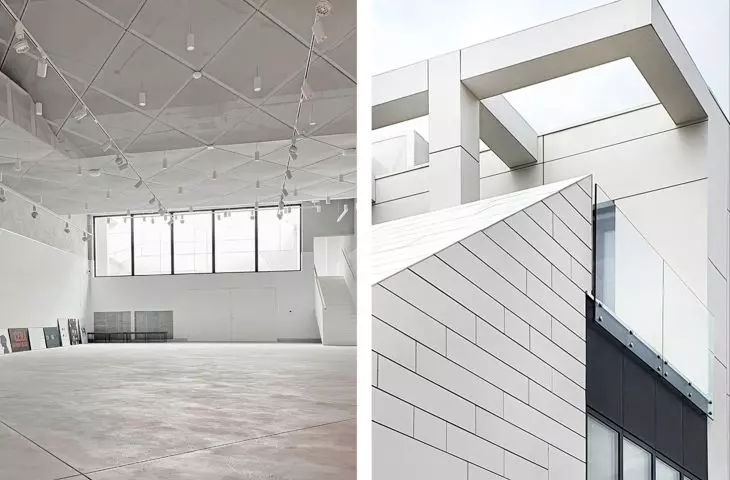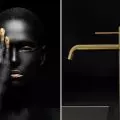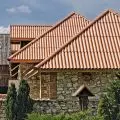The discussion of introducing new elements into the historical fabric has often been one of the main topics of recent years. These issues have also been taken up by designers from the 55Architekci studio in the project for the Ada Sari Cultural and Art Center in Stary Sącz.
Wojciech Swiatek, an architect from the 55Architekci studio, talks about fitting into the local context, combining the historic with the new and the necessity of creating places of culture.
Wiktor Bochenek: Thefirst concepts for the Ada Sari Cultural and Art Center in Stary Sącz were controversial in Stary Sącz. Were you eventually convinced of the new form?
Wojciech Swiatek: Those really first concepts, were definitely less conservative than the object in its present form, one could say, a bit subversive. In the beginning, we were attracted to, and in fact, a bit deluded by, the very theme of a melting pot cultural center, where all energy and expression is accumulated, where manifesto and contra seem to have a privileged position. We focused primarily on the issue of representing such a center with the language of form, material, color. It seems to me that "coming to terms" was a natural part of the negotiation process in weighing and evaluating all the relevant parts for the set.
The Ada Sara Cultural and Art Center in Stary Sacz (proj. 55Architekci)
© 55Architekci
Victor: How did the idea for such a solid solution come about? How did you try to integrate the solid into the surroundings?
Wojciech: Leaving the front of the historic building renovated and maintaining its role in the frontage of the Market Square, it was obvious to orient ourselves with the expansion deeper into the plot. Outside the building line of the Old Nowy Sącz Market Square, the outbuildings - small in volume - growing perpendicularly at the back are characteristic. We decided to join this trend, keeping the volume of the visible part and the height in check and using the shape of the neighboring building to anchor the extension. We treated the part with the pent roof as the front of the building from the square, and the clear cutoff generated by its ridge was a pretext for proposing a terrace and a subsequent more spacious volume, a little more independent in the composition of the mass.
However, a large part of the extension was hidden under the first floor level to preserve the scale of the neighborhood, despite the introduction of the cultural building into the historic (and well-preserved) market housing (mostly 1-story buildings covered with pitched roofs. We chose the material because of two issues - first, a bright surface with an elegant finish, which can be seen, especially up close, and to make secondary divisions, here and there introducing threads of historical narrative or providing a counterbalance to the solid block.
Ada Sary Cultural and Art Center in Stary Sącz (designed by 55Architekci)
© 55Architekci
Wiktor: How was the internal layout of the building solved? What was the most important thing here?
Wojciech: The most important thing seemed to us from the beginning to create a scenario for the functioning of the building, for moving around it. In this structure, the key was to integrate the existing part with the newly designed one - through the stone basement on level -1. The extension primarily houses workshop activity rooms, of course the exhibition, and the main hall with a café. In the initial estimation and typical expansion, we came out with relatively little additional space for exhibitions. Rooms, studios, workshops, were not such a significant problem due to their limited size requirements and natural need for separation - we had such "boxes" in the reconstructed building. We decided to propose an approach to expand the public space of the existing small square, with the hitherto closed courtyard of the "House on the Pits" adjacent to the project. - Regional Museum in Stary Sącz. Such a move would give us the opportunity to create the more extensive public space that the new facility would need, besides, it would give us a chance to combine the strengths of the two cultural buildings. The argument maintained at the end was the plan to make a decidedly larger - one exhibition space for the CKiS - in the underground, under the public square precisely.
We were extremely encouraged by the open attitude of the authorities of Stary Sącz, as well as the Conservator of Historical Monuments - we were given permission, based on the concept presented, to design in this direction. Having such a framework for design, we completed the idea of the building. The structure of the interiors resulted not only from the available volume, certain limitations of the narrow plot, but already from the decision on the urban scale, the project arranged and changed the face of part of the Old Town quarter. As a result, the Cultural Center has become present - connected to the existing buildings, it has several access points (entrance to the underground Hall from the southern part of the square), the scenario of changing interiors extends to the immediate, external surroundings.
Ada Sara Cultural and Art Center in Stary Sącz (proj. 55Architekci)
© 55Architekci
Wiktor: How was the external environment, primarily the inner courtyard, resolved?
Wojciech: As I mentioned, the possibility of giving back to the public - including in the development of the unused courtyard of the Regional Museum and integrating the neighboring square were the most important decisions. Actually, the impetus for such a concept was another one executed earlier - for a Park&Ride system with a trail leading to the city center, just through this area. It all stuck together quite logically for us.
The inner courtyard itself is primarily paved with stone slabs, which, given the green square, came without remorse. The obvious need was to provide a space assigned to the CKiS, which could serve as a festival alley for outdoor exhibitions, or an outdoor cinema hall - we even designed a screen on the largest glass of the first floor..., I don't know if it was used :). We have to ask. It is worth saying that in arranging this small space, we used elements that were in it - unnoticed, like a tiny chapel, or a disused old well.
The Ada Sara Cultural and Art Center in Stary Sacz (proj. 55Architekci)
© 55Architekci
Wiktor: What is the most important thing when introducing modern forms into a historic fabric?
Wojciech: It's hard to say... With us it always starts abruptly, we approach each place individually. We never know, starting work on a project, where the analysis will lead us, what the final solution will be. Analyzing, we get to know the problems and these problems we try to solve - in this location it was the lack of space for external events, but above all the need to fit an extensive functional program into the scale of the development, the urban layout and to create a facility that is a reflection of contemporary culture and the possibilities of a small center with a rich history, such as Stary Sacz.
Of course, there are certain rules, related to reading the context, its architectural character, determinants of composition, scale, or detail, but it seems to me that they serve (deliberately applied) primarily to not do harm to a given space, to calibrate one's design tools through such an estimate. However, the whole clue is to find a creative solution - one that fits with what has been shaped over the centuries, but is a reflection of our contemporary culture, an expression of the author's idea. The circumstances created by the historic fabric require great care, attentiveness and, however..., a more precise argumentation. Besides, urban planning is extremely inspiring, not only the current state, also the threads that have remained traces of some history, traditional activity, or customary use of space. In the CKiS project, one of these became an important causal factor for the concept.
The Ada Sara Cultural and Art Center in Stary Sącz (proj. 55Architekci)
© 55Architekci
Wiktor: What was the biggest problem in designing this building, and what gave you the most satisfaction?
Wojciech: The problematic things, both in the design and, as it turned out later, in the construction, were things that you can't fully know without dismantling the existing building and digging up the entire site. Spot excavations don't tell you everything about the foundation, the technical condition of the building elements also turned out, usually, to be a little worse, sometimes forced changes in technology - such as the availability of subcontractors in the market. It was a very exploitative process for us. Satisfaction came at the end of this adventure, essentially in accordance with our plan, with no significant deviations from our point of view..., yes it was a distinct relief... and satisfaction. The project also caused a lot of thinking about the conditions for practicing architecture, but that's a topic for another conversation.
Victor: Thank you for the interview!
The Ada Sara Cultural and Art Center in Stary Sacz (proj. 55Architekci)
© 55Architekci







































